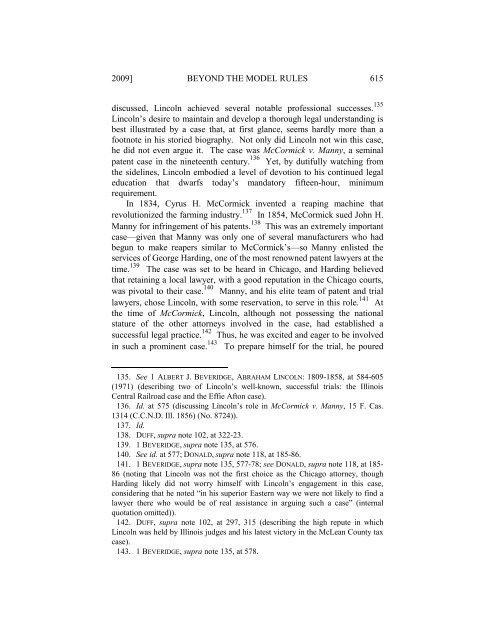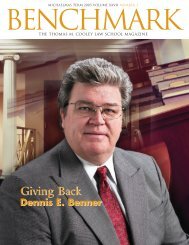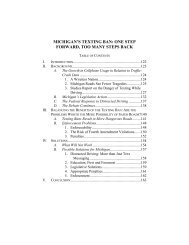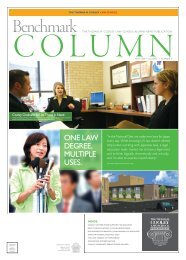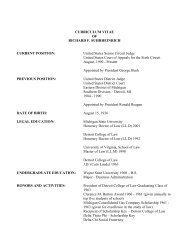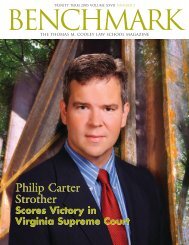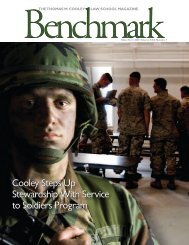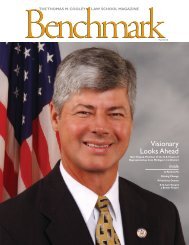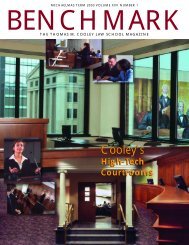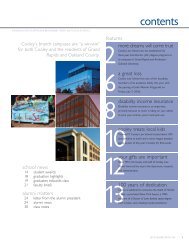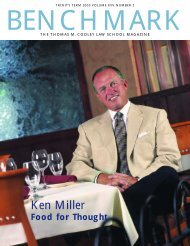Beyond The Model Rules - Thomas M. Cooley Law School
Beyond The Model Rules - Thomas M. Cooley Law School
Beyond The Model Rules - Thomas M. Cooley Law School
Create successful ePaper yourself
Turn your PDF publications into a flip-book with our unique Google optimized e-Paper software.
2009] BEYOND THE MODEL RULES 615discussed, Lincoln achieved several notable professional successes. 135Lincoln’s desire to maintain and develop a thorough legal understanding isbest illustrated by a case that, at first glance, seems hardly more than afootnote in his storied biography. Not only did Lincoln not win this case,he did not even argue it. <strong>The</strong> case was McCormick v. Manny, a seminalpatent case in the nineteenth century. 136 Yet, by dutifully watching fromthe sidelines, Lincoln embodied a level of devotion to his continued legaleducation that dwarfs today’s mandatory fifteen-hour, minimumrequirement.In 1834, Cyrus H. McCormick invented a reaping machine thatrevolutionized the farming industry. 137 In 1854, McCormick sued John H.Manny for infringement of his patents. 138 This was an extremely importantcase—given that Manny was only one of several manufacturers who hadbegun to make reapers similar to McCormick’s—so Manny enlisted theservices of George Harding, one of the most renowned patent lawyers at thetime. 139 <strong>The</strong> case was set to be heard in Chicago, and Harding believedthat retaining a local lawyer, with a good reputation in the Chicago courts,was pivotal to their case. 140 Manny, and his elite team of patent and triallawyers, chose Lincoln, with some reservation, to serve in this role. 141 Atthe time of McCormick, Lincoln, although not possessing the nationalstature of the other attorneys involved in the case, had established asuccessful legal practice. 142 Thus, he was excited and eager to be involvedin such a prominent case. 143 To prepare himself for the trial, he poured135. See 1 ALBERT J. BEVERIDGE, ABRAHAM LINCOLN: 1809-1858, at 584-605(1971) (describing two of Lincoln’s well-known, successful trials: the IllinoisCentral Railroad case and the Effie Afton case).136. Id. at 575 (discussing Lincoln’s role in McCormick v. Manny, 15 F. Cas.1314 (C.C.N.D. Ill. 1856) (No. 8724)).137. Id.138. DUFF, supra note 102, at 322-23.139. 1 BEVERIDGE, supra note 135, at 576.140. See id. at 577; DONALD, supra note 118, at 185-86.141. 1 BEVERIDGE, supra note 135, 577-78; see DONALD, supra note 118, at 185-86 (noting that Lincoln was not the first choice as the Chicago attorney, thoughHarding likely did not worry himself with Lincoln’s engagement in this case,considering that he noted “in his superior Eastern way we were not likely to find alawyer there who would be of real assistance in arguing such a case” (internalquotation omitted)).142. DUFF, supra note 102, at 297, 315 (describing the high repute in whichLincoln was held by Illinois judges and his latest victory in the McLean County taxcase).143. 1 BEVERIDGE, supra note 135, at 578.


